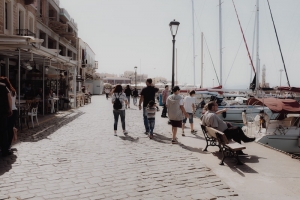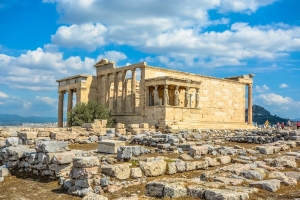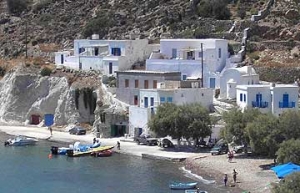BUSINESS CENTRE
XpatAthens
Top Things To Do In Greece With Teenagers
Athens is known for its vibrant street art scene, and many travel from far to discover this unique form of art that young people have used for years as a way to express themselves in a climate of economic turmoil. As the art is constantly changing, you will get to see fascinating and politically-charged graffiti and colorful designs that will surely interest your kids (and maybe end up on your teen’s phone as a screen saver).
Greece may be known for its beaches and islands, but it is a mountainous country. With high, rugged peaks covering the territory, it is a country ideal for hikers and trekking enthusiasts.
Kids and teenagers have a lot of energy, and being in the country where the Olympic Games were born is an excellent excuse to tap into that overabundance of energy to put it to good use! Most of the popular destinations in Greece have tennis courts, swimming pools, water parks, surf centers, windsurfing, and more!
‘Event-ually Athens’ Campaign Promotes The Greek Capital As Year-Round Destination
ACS Athens Takes Its Partnership With Widener University To The Next Level
On April 4, 2019, representatives from Widener University and ACS Athens gathered at the Widener campus in Chester, Pennsylvania, to sign an agreement expanding the established partnership between the two schools and promoting their shared vision for education. Under the agreement, graduate programs will be offered focused on K-12 international school leadership. The agreement also allows for ACS Athens high school students to take online undergraduate courses.
Dr. Julie E. Wollman, President of Widener University, welcomed Dr. Stefanos Gialamas, ACS Athens President, Dr. Peggy Pelonis, ACS Athens Vice President and Mr. Iraklis Prokopakis, Treasurer of the Board of Trustees of ACS Athens, together with Paul Beideman, Vice Chair of Board of Trustees of Widener University and Provost Dr. Fred Akl.
Dr. Wollman highlighted: “We already have a memorandum of understanding (MOU) with our partners at ACS Athens and now we are expanding this MOU to be able to offer graduate programs to the outstanding teachers at this special school and also to be able to offer some courses for the students who wish to take college courses while they are still in high school. This is an opportunity to expand what is a wonderful partnership and we are very excited about it”. Also, Dr. Wollmann is now the newest member of the International Advisory Council of ACS Athens.
Dr. Stefanos Gialamas, ACS Athens President, remarked: ”It is very important that as the President of the Middle States Association told me, two institutions accredited by Middle States Association are getting together not for one more partnership but to pioneer the effort to bridge the gap between K-12 and higher education in terms of not only teaching and learning but also as a different way of thinking. Today, we don’t have to endure a financial crisis but more importantly an ethical one. Widener U. and ACS Athens have the same beliefs and both want to prepare tomorrow leaders with Ethos.” Also attending the signing were Nicholas Karambelas, Vice Chairman of the Board of Trustees, Arti Gyftopoulos, Board of Trustees member, and Dr. Konstantinos Koutras, Consul General of Greece in New York, who expressed their support of this partnership.
A video recording of the signing is available HERE!
Winter Quiet Hours Are Back
Discover Tinos, A Year-Round Greek Island
Even if you are not inclined to go on a pilgrimage, Our Lady of Tinos is still worth visiting. The nineteenth-century church sits on a hill above Chora, Tinos' capital, and is built in a Renaissance architectural style that sets it apart from traditional Greek churches. The shrine's icon is also worth seeing, regardless of one's beliefs. Its image is barely visible through the impressive collection of votive silver, gold, pearls, and precious stones that have been left by pilgrims and encased within the frame.
One of Tinos' most impressive features, though, is that it houses over 700 small churches. Some were built during the Byzantine era, but most were built after the Venetians conceded Tinos to the Ottomans. Through a special agreement with the Ottoman leaders, the Tinian people were granted permission to construct an infinite number of churches. Since owning a church was considered a blessing, a small chapel was erected in each property-a practice that is still very common on the island. In fact, in Tinos, you will definitely come across chapels in bizarre locations such as forests and narrow mountainous valleys.
Tinos is also known for the unique eighteenth-century dovecotes, or pigeon houses, that spot its mountainous terrain. They are a rare example of folk Greek architecture, and, while some of the other Cycladic islands also have traditional dovecotes, the pigeon houses on Tinos are the largest and most ornate.
ERGOSE Saves Hundreds Of Centuries-Old Olive Trees
ERGOSE, a subsidiary of the Greek Railway Operator constructs and maintains the railway network of the country.
During railway works, a large number of trees that would have otherwise been destroyed have been unrooted, carefully transferred, and re-planted in other areas of the country.
Recently, the company managed to save a 4-centuries old olive tree from a construction site in Patras, Peloponesse. The tree was carefully transferred and planted somewhere else in Greece.
The devastating wildfires in Eastern Attica in July 2018 not only claimed numerous human lives but were an environmental disaster that ruined the landscape in Marathon. A year later, more than 60 olive trees were planted in the cities of Marathon and Rafina, the places most affected by the 2018 wildfires.
New Framework For EU Forest Monitoring & Strategic Plans
The European Green Deal calls for action to improve the quantity and quality of forests in the European Union, so the EU can reach its goal of climate neutrality and creating a healthy environment. The new EU Forest Strategy for 2030 sets the vision for effective afforestation, forest preservation, and restoration in Europe. The Strategy also announces a legislative proposal for a forest observation, reporting and data collection framework and requires the Member States to prepare strategic plans for forests.
In addition to improving forest monitoring, this information will lead to more data-driven decision-making on forests. It is expected to increase public trust in forest management, reduce illegal logging, incentivize and reward more sustainable forest management, and support the adaptation of forests to climate change. This initiative will also help deliver a Europe fit for the digital age as it will empower people, businesses, and administrations by providing access to harmonized forest-related data and making better use of digital technologies.
To read this article in full, please visit the European Commission's official website.
Great Escape Rooms Around Athens
1. Woman in Black – Coven Escape Rooms
📍 Sapfous 143, Kallithea
⏱ 1h 40m | Difficulty: 8/10 | Horror | Greek & English
Step into the haunted village of Grithin Gifford, where locals whisper about a mysterious woman dressed in black, a shadowy figure said to bring death to anyone who dares cross her path. You’re sent from London to find the will of the last tenant of the decaying mansion across the marsh road, but beware: some secrets are best left buried.
Not for the faint-hearted — this experience is strictly 18+ and not recommended for players with heart or breathing conditions, claustrophobia, epilepsy, or panic attacks.
2. Monika’s Diary – Bang Bang Theory Escape Rooms
📍 Aristotelous 19, Kallithea
⏱ 1h 30m | Difficulty: 9/10 | Horror | Greek & English
At just 12 years old, Monika disappeared without a trace after years of grief over her mother’s suicide. Her father, Frank, was left behind in the old family house, where strange sounds and shadows still linger. Now, years later, new evidence has surfaced, and the case is reopened.
You and your team are among the investigators stepping into the house to uncover what happened, but nothing is what it seems. And when a certain object comes alive… run.
P.S. Frank is one of the best actors you'll come across in an Escape Room!
3. Paradox Project 2: The Bookstore – Paradox Project
📍 Charokopou 93, Kallithea
⏱ 3h 20m | Difficulty: 9.5/10 | Investigation | Greek & English
One of the most acclaimed escape rooms in the world, The Bookstore is an epic, cinematic experience that continues the story from The Mansion and precedes The Music Academy.
After your last adventure, you’ve left something behind and the consequences are now catching up with you. Shadows from your past are closing in, and the line between truth and illusion begins to blur.
Awards:
-
#2 Best Escape Room in the World (TERPECAs 2019 & 2020)
-
#1 Best International Escape Room (Escape Room Awards 2021)
-
#1 Top Live Escape Room (Escape Roomers DE Awards)
-
Golden Lock Award (Room Escape Artist, 2020)
This one’s an absolute must-try.
4. Truth or Dare – Clock Escape Rooms
📍 Dorieon 7 & Lagada, Agia Paraskevi
⏱ 1h 50m | Difficulty: 9/10 | Investigation | Greek & English
In 2005, a drunken joyride after a graduation party ends in tragedy; a hit-and-run that’s buried deep in the past. Eighteen years later, the five friends responsible receive a mysterious invitation: someone knows their secret.
It’s a gripping psychological thriller full of moral dilemmas, plot twists, and dark revelations. Truth or dare, which will you choose?
5. The School of Burning Souls – Lockdown Escape Rooms
📍 Paleon Patron Germanou 12, Nea Ionia
⏱ 1h 40m | Difficulty: 7/10 | Horror | Greek & English
In 1986, tragedy struck Bloodwood Elementary School when a fire consumed everything, except a few survivors. Decades later, you return to uncover the truth of what really happened that night.
As you walk through the charred remains of your childhood school, memories and phantoms intertwine. Some ghosts never rest… and some memories are better left forgotten.
6. Anna’s Dream
📍 Eleftheriou Venizelou 111, Nea Ionia
⏱ 1h 30m | Difficulty: 7/10 | Séance Activity | Greek Only
If you’ve ever wondered what it’s like to sit in a real séance, candles flickering, whispers in the dark, and the feeling that something unseen is watching — this room is for you.
Unlike traditional escape rooms, here the goal isn’t to escape, but to enter another world. Guided by the story of a Victorian medium, you’ll be invited to communicate with her restless spirit and uncover the dream that haunted her until death.
Prepare for a unique, spine-tingling experience where logic takes a backseat to atmosphere, instinct, and courage.
7. Left Alone – Dark Matter Escape Rooms
📍 Aristidou 16, Agioi Anargyroi
⏱ 1h 40m | Difficulty: 7.5/10 | Horror | Greek & English
“My beloved grandchildren… when will you visit me?”
Haunting, emotional, and deeply psychological, Left Alone explores loneliness, fear, and regret through the eerie story of an elderly woman left behind. Is it just grief haunting this house or something much darker?
This room will stay with you long after you leave it.
Whether you’re chasing jump scares, solving intricate puzzles, or diving deep into cinematic storytelling, Athens’ escape room scene is unmatched. With hundreds of options scattered across the city, you can find a room that suits your mood, from light-hearted mystery to full-blown horror.
So grab your friends, steady your nerves, and prepare to get locked in. The real question is… can you escape?
Sightseeing In Kimolos
Horio is not only the main village in Kimolos, but also the island’s capital with inhabitants accounting for 90% of the island’s entire population which is nearly 800 residents. Situated in the southeastern part of Kimolos on the foot of mount Xaplovouni, the capital exudes a sense of old-world charm adorned with the brilliant architectural style of the Aegean.
The silver lined beaches, the white washed walls with the blue painted windows and the narrow pebbled streets surrounding them create an artistic landscape of tranquility. Filled with places of interest it is the principal spot of attractions and sightseeing on the island.
The Medieval Castle
Dating back to the 14th or the 16th century the Medieval Castle is located up town and comprises of the inner castle (in ruins) and the outer castle that still stands even after the pirate attack of 1638. The castle is a characteristic example of the Aegean fortification architecture with houses side by side built from solid rock, white washed walls and steel doors.
The Archeological Museum
Situated opposite to the Metropolitan church of Panagia Odigitria, the Archeological Museum hosts exhibits and archeological findings showing the history of the island including vessels and utensils from the early 7th century B.C.
To read more, please visit cycladia.com
The Best Sour Cream Substitute? Greek Yogurt
Are you having a hard time finding sour cream in Athens? Well, you can stop looking. It turns out that the best sour cream substitute, Greek yogurt, is by far the most versatile of dairy products. It is ideal to use in all types of cooking. You can use Greek yogurt to also replace cream, mayonnaise or cream cheese. You can use it cold for dips, to mix through salads, pasta or potato for a creamy finish, in ice creams or you can add it to hot meals.
Greek yogurt is an ideal yogurt for cooking as it can stand high heat without curdling. It is available in no fat, low fat and extra creamy, so there will be one to suit your needs.
Here are some suggestions for using Greek yogurt in your meals.
Makes Soups Creamy
• Chicken or vegetable soup, once cooked and blended, warm soup, remove from heat. Stand for 2-3 minutes. Stir yogurt through the soup, just long enough to warm through, then remove and serve.
• For dishes such as Beef Stroganoff, add it just at the end, stir through, then serve.
Cold Pasta Dishes
• You can use it in cold pasta salads, cooked pasta, tinned or freshly cooked fish, ham bacon or cooked chicken, diced red & green peppers, tomatoes, parsley, stir through yogurt or combination of mayonnaise and yogurt, salt and pepper to taste.
• Alternative dressing, yogurt, mayonnaise, seeded/grainy mustard, herbs – chives, parsley, etc, mix together. Add a little water if you prefer it runnier. Mix through pasta.
Hot Pasta Dishes
• Add yogurt as a sour cream substitute to the pasta sauce just before the end. Finish cooking the sauce, turn off the heat, add the yogurt and stir through until just warm. Remove and serve.
For more, please visit Ultimate Guide to Greek Food











